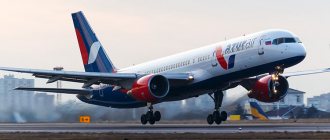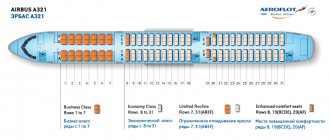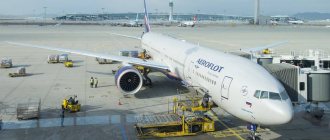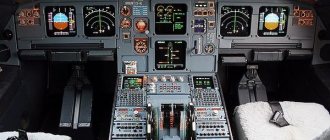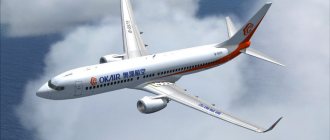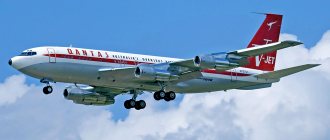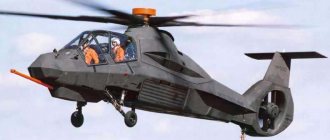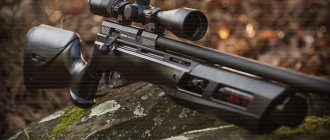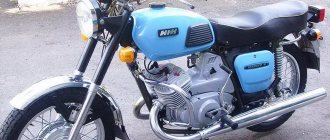17.09.2019
Boeing 787 Dreamliner (dream plane) is a wide-body twin-engine passenger aircraft. Initially it was planned to be created as a subsonic airliner, that is, flying at transonic speeds, however, it later became a conventional subsonic jet aircraft. The aircraft is a long-haul aircraft.
Named Sonic cruiser at the beginning of development, the aircraft received the code designation 7X7, and closer to the start of production - the existing name 787.
History of the development of the Boeing 787 Dreamliner passenger aircraft
Sonic Cruiser
By the beginning of the 21st century, the Boeing Corporation realized that the previous long-range model, the Boeing 767, was outdated. Competition with the Airbus concern, which produced models such as the 330 and 340, has intensified. To stay on par with its competitor, Boeing decided to make a qualitative leap in aircraft production, and in 2001 announced the development of a new airliner - the Boeing Sonic Cruiser. According to the manufacturer's press release, the subsonic Boeing will maintain a speed close to sound, but at the same time consume less fuel than classmates. However, airlines said they were looking for efficiency and speed was not as important. Therefore, the development of such a complex aircraft was canceled.
Boeing 787
On April 26, 2004, Boeing held a presentation of its new project. The code name of the new aircraft is 7E7. This development was presented as the successor to Sonic Cruiser. Many ideas and technologies were borrowed from his predecessor. In the winter of 2005, Boeing announced the name of the new model - Boeing 787.
The rollout of the new aircraft took place in the summer of 2007, however, it was possible to put the aircraft on the wing only at the end of 2009.
In the summer of 2011, a Boeing 787 made its first flight from Seattle (USA) to Tokyo. Then, starting on July 4, 2011, the aircraft conducted test flights between Japanese cities for a week.
Boeing 787 aircraft
On August 26, 2011, the aircraft received aircraft type approval. The first commercial flight took place on October 26, 2011.
On June 16, 2014, the 787-9 was certified with a stretched fuselage and increased passenger capacity.
At the end of 2020, more than 300 million passengers had flown on the 787. Due to the increased range, 210 new non-stop routes were opened.
Links
- 787 Dreamliner on the official Boeing website
- Boeing 787 Dreamliner on newairplane.com
- A look at the interior of the Boeing 787 (Russian) translation article on the Habrahabr website
- What do passengers feel? An illustrated story about how a passenger feels during a flight on a Boeing 787
- Detailed photo tour of Dreamliner at MAKS-2011
- The plane is a dream. Boeing-787 (I want to tell you a little about the Boeing-787) romadm.livejournal.com
- How to buy airplanes A story from blogger Sergei Dolya about the advantages of an airplane and how representatives of aviation in titanium buy airplanes. TV story from September 3, 2010
- Boeing 787-9 Dreamliner TV footage from the 2014 Farnborough Airshow
| Boeing 787 Dreamliner at Wikimedia Commons |
Description of design and technical characteristics
The aircraft is a twin-engine turbofan low-wing aircraft with a swept wing and one fin (rudder).
The Boeing 787 was the first aircraft to be made with large amounts of composite materials. Each aircraft contains about 35 tons of composite materials. Composites are used in the production of fuselage, wings and other parts of aircraft. Because of this, the manufacturer managed to greatly lighten the aircraft.
The wing plane is swept, the tips have variable camber, due to which the lift force has increased by 2 percent compared to the previous model.
The engine also uses a large number of composite parts, which reduces the amount of harmful emissions into the atmosphere and increases power.
The aircraft's "plastic" wings increase lift by 2% compared to previous models.
Due to new interior solutions, the luggage compartment volume has increased by 45% compared to the Boeing 767.
Cockpit
The cockpit of the Boeing 787 is “glass”, that is, instead of dial instruments, screens are used on which the necessary information is displayed, including flight and approach diagrams. It is also worth noting that Boeing uses a classic steering wheel for control, and not a control stick, like Airbus.
Boeing 787 cockpit view
Construction[ | ]
Boeing 787-8 of Japan Airlines
Low-wing aircraft with a normal aerodynamic configuration, with a swept wing and single-fin tail. Two turbofan engines.
50% of the fuselage elements are made of carbon-based composite materials (in the 777 this is only 9%). As a result, the 787 is lighter and stronger than a conventional aircraft with an aluminum fuselage.
General Electric's quiet, ultra-efficient GEnx engine is one of two powered by the 787 (the other being Rolls-Royce's Trent 1000).
In the GEnx engine, both the housing and the fan blades are made of composite materials, only the leading edge is metal. As a result, the engine reaches operating traction mode at lower temperatures, which, accordingly, produces lower volumes of hydrocarbon emissions. [ source not specified 2605 days
] Both engines for the 787 have the same interface for connecting to aircraft systems, which allows you to change the type of engines during aircraft operation[20]
The 787 model's swept wing planes with variable tip camber increase lift by 2% compared to the 767 model. These wings are longer than other aircraft of this class, which gives them additional elasticity. In normal flight, the wing tips deviate by 3 meters relative to the free position on the ground; during static tests at 150% of the maximum design load, the wing tips deviated by 7.6 m [21]. The flap mechanisms, electrical anti-icing equipment and other systems are mounted as a single unit, which facilitates their maintenance and reduces the likelihood of failures.
The luggage compartment, thanks to the flat bottom of the fuselage, allows you to accommodate 45% more luggage than fit in the Boeing 767 model.
Cockpit[ | ]
In the Boeing 787 cockpit, head-up displays (HUDs) are mounted in front of the pilots. The control system includes the so-called “electronic flight plan” - two screens (one for each pilot), which display taxiing, approach and terrain maps.
Sensors in the nose of the aircraft measure turbulence and command the setting of aileron deflection angles. According to Boeing, this system reduces passenger discomfort resulting from turbulence.
Diagnostics
Using a broadband radio communication channel in real time, the automatic diagnostic system sends data to the ground repair service. This system can independently predict the occurrence of certain problems in aircraft mechanisms, which promises to reduce the likelihood of delays and reduce the time spent on diagnostics and repairs.
Passenger cabin[ | ]
Boeing 787-8 aircraft
The cabin of the Boeing 787 is 40 cm wider than that of its predecessor, the Boeing 767, which made it possible to install more seats. The size of toilets has increased. Now, by deploying the partition between them, you can organize access for people in wheelchairs. The overhead luggage racks have become significantly more spacious, and each of them can accommodate four suitcases with wheels, which is significantly more than its predecessors.
The height of the windows is 46 cm - this is a record among all commercial airliners. The windows are equipped with adjustable electrochromic dimming.
The on-board wireless connection delivers entertainment programs to seatback monitors, and the satellite system allows passengers to use broadband Internet (250 kbps).
Pressure maintenance system
The 787's more resilient composite body allows cabin pressure to be maintained at a level corresponding to an altitude of 1,800 m, whereas the pressure in the cabin of a conventional aluminum passenger aircraft corresponds to an altitude of 2,400 m.
Climate control
The cabin pressurization system is organized in a new way. Unlike other passenger aircraft, where air supplied to the cabin is taken from engines with a temperature of more than 600 degrees, passes through coolers and enters the cabin, in the Dreamliner the air is supplied to the cabin by electric compressors directly from the external environment. This eliminates the problem of insufficient air humidity. More humid air inside the Dreamliner provides greater passenger comfort.
The technical characteristics of the aircraft are given in the table:
| Option | 787-8 | 787-9 | 787-10 |
| Crew | Two people | ||
| Passenger capacity | 242 (2 classes) | 290 (2 classes) | 330 (2 classes) |
| Length | 56.69 m | 63 m | 68.27 m |
| Wingspan | 60.17 m | ||
| Wing area | 325 m2 | ||
| Wing sweep angle | 32,2 | ||
| Height | 17 m | ||
| Fuselage dimensions | Width: 5.77 m Height: 5.97 m | ||
| Cabin width | 5.49 m | ||
| Cargo capacity | 138.2 m³ 28 LD3 containers | 174.5 m³ 36 LD3 containers | 192.6 m³ 40 LD3 containers |
| Maximum take-off weight | 227,930 kg | 254,011 kg | |
| Maximum landing weight | 172,365 kg | 192,777 kg | 201,849 kg |
| Maximum weight without fuel | 161,025 kg | 181,437 kg | 192,777 kg |
| Empty weight | 118,000 kg | 126,000 kg | N/A |
| Engines | 2×General Electric GEnx-1B or 2×Rolls-Royce Trent 1000 | ||
| Engine thrust | 280 kN | 320 kN | 340 kN |
| Fuel consumption | 4800 kg/hour | 5400 kg/hour | 5700 kg/hour |
Content
- 1 History 1.1 Sonic Cruiser
- 1.2 Boeing 787
- 1.3 Suspension of flights
- 2.1 Cockpit
- 3.1 Engines
- 4.1 Current options
Flight characteristics of the Boeing 787
| Option | 787-8 | 787-9 | 787-10 |
| Cruising speed | 0.85 M (902 km/h) | ||
| Maximum speed | 0.90 M (956 km/h) | ||
| Range of flight | 13,620 km | 14,140 km | 11,910 km |
| Run length | 3100 m With modernization: 2600 m | 2900 m | N/A |
| Fuel reserve | 126,000 l (101,000 kg) | N/A | |
| Ceiling | 13 100 m | ||
Interior layout and seating arrangement
When designing the Boeing 787, it was possible to increase the cabin by 40 cm compared to its predecessors. This made it possible to expand the space of the overhead luggage racks and toilets.
The height of the windows is also a record among all passenger aircraft - 46 cm.
At each seat in the back of the seat in front there is a monitor on which films, music and other content available in the on-board entertainment system can be shown.
An example of a two-class layout of a Boeing 787 Dreamliner
Let's look at the layout of seats in a three-class cabin using the example of United Airlines.
| Internal elements | United PolarisSM business class | United Economy Plus | United Economy |
| Number of seats | 48 | 88 | 116 |
| Seat numbers | 1A-8L | 16A-24L, 27BCJK, 29DEF | 27AL, 28A-L, 29ABCJKL, 30A-41F |
| exits | In front of the salon, row 5 | 27 row | Rear cabin |
| Seat configuration | 2-2-2 | 3-3-3 | 3-3-3 |
| Seat length | 6'6″ (198 cm) converts to sleeper | 35″ (88 cm) | 32″ (81 cm) |
| Seat width | 20.6″ (52.3 cm) | 17.3″ (43.9 cm) | 16.3″ – 17.3″ (41.4 cm – 43.9 cm) |
| WiFi | Yes | Yes | Yes |
| Sockets | Yes | Yes | Yes |
| USB ports | Yes | Yes | Yes |
| Possibility of attaching a cradle | 6AB, 6KL | 16ABC, 16DEF, 16JKL, 29DEF | — |
Business Class
Business class provides excellent opportunities for a comfortable flight. The seats turn into a bed and allow you to get a great night's sleep on a long, transoceanic flight. Food from the world's best chefs and excellent amenity kits will make your flight unforgettable. Each seat has a separate passage so as not to disturb the neighboring passenger.
Business class seats using the example of JAL airline
Premium class
Premium seats
Premium, otherwise known as premium economy, is a class that, of course, is inferior in comfort to business, but nevertheless provides comfortable seats for long-distance flights. The recline angle of the backrest, although it does not turn the seat into a bed, is still not bad.
Economy class
Economy class cabin
Economy class provides seats that are upgraded from its predecessor, the 767. With in-flight Wi-Fi and an integrated entertainment system, Economy Class is quite convenient for passengers who choose it for their flight.
Advantages and disadvantages of 787
The main advantage of the aircraft is the use of a large number of composite materials - the aircraft has become much lighter.
Thanks to the composite fuselage, it was possible to maintain the pressure in flight at a level of 1800 m, as opposed to the usual 2400 m. To improve the flight conditions on board, air is supplied by compressors directly from the environment, and not from the engines. This eliminates the problem of dry air at the flight level and increases the comfort of the flight. So, for example, the standard level of air humidity in flight is 4%, in the 787 the humidity is 15%.
Due to the use of a new shape of the rear cut of the engine nacelles (“teeth”), it was possible to reduce the noise of the aircraft by more than 15%.
Broadband data transmission (BDT) over a radio channel allows the board to report flight parameters to ground services in real time.
The use of an automatic system that deflects the ailerons during shaking improved the aerodynamics of the aircraft and its behavior in turbulence.
However, it should be noted that the aviation authorities of the United States and the European Union stopped the aircraft from flying in January 2013 due to problems with the batteries. After the investigation, flights were resumed in April 2013.
Noise Reduction Measures
Engines
Boeing and NASA have developed a new cut shape for engine nacelles. The trailing edge of the engine nacelles is serrated. The teeth were called "chevrons". According to Boeing, this solution reduces engine noise due to a smoother mixing of the jet stream with the surrounding air and saves several hundred kilograms of sound-proofing materials. The developers also experimented with variable geometry chevrons, using alloys that change their shape depending on temperature. Such chevrons must bend into the jet stream during takeoff and return to their original position during cruising flight. According to the developers, the measures taken made it possible to reduce external and internal noise by 15 [22].
Other design elements
NASA, together with Goodrich, have developed shields that are installed between the wheels and reduce noise during landing gear extension. NASA was responsible for computer modeling, equipment manufacturing, and wind tunnel purge[22].
Boeing 787 modifications
Currently, Boeing offers its customers three modifications of the aircraft. A fourth was planned, the 787-300, with a shorter range (for Japanese domestic routes), but its production was canceled in 2010.
Boeing 787-8 (787-800)
Basic version. It was the first to enter the market and began to be supplied to customers. It was planned as a replacement for the Boeing 767-200ER and Boeing 767-300ER. The model is designed to carry 242 passengers over a distance of 13,600 km.
Boeing 787-9 (787-900)
This model has a fuselage extended by 6.1 m. The wings have not changed. Can transport up to 280 people over a distance of 14,140 km.
Boeing 787-10 (787-1000)
The development was presented on June 18, 2013 at the airshow in Le Bourget. Carrying 330 passengers over a distance of more than 11,000 km, this aircraft was planned as a competitor to such models as the Boeing 777-200, Airbus A330 and Airbus A340. To produce this aircraft, the wings had to be enlarged and shifted relative to the fuselage. The landing gear also had to be moved to reduce the likelihood of the extended tail hitting the runway.
The plane and its modifications ended up being very successful. A better microclimate during the flight, providing greater comfort to passengers. The plane seems to be pushing you to choose this plane on your next flight.
If you have any questions, leave them in the comments below the article. We or our visitors will be happy to answer them
